
# 1686e - 1976 13c Hamilton, Laurens, Stewart
Birth Of Alexander Hamilton
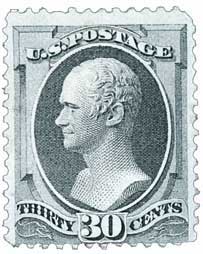
Alexander Hamilton was born on January 11, 1755 (or 57 – the year is unknown), in Nevis in the British West Indies.
Hamilton began working as a clerk in an accounting office when he was about 11 years old. When his employer realized how bright Hamilton was, he sent him to America for an education. In 1773, Hamilton arrived in New York and attended King’s College. His focus soon turned from education to politics. The following year, he wrote his first article in defense of the patriots’ protests of British taxes.
As the Revolutionary War began, Hamilton commanded the New York Provincial Company of Artillery. He became an assistant to General George Washington, writing many of his letters and reports. In 1781, Hamilton led a charge at the Battle of Yorktown that helped end the war. After the war, Hamilton studied law, then opened a practice in New York City. He represented many Loyalists who had supported England during the Revolution. Hamilton’s cases helped establish the principle of due process in America.
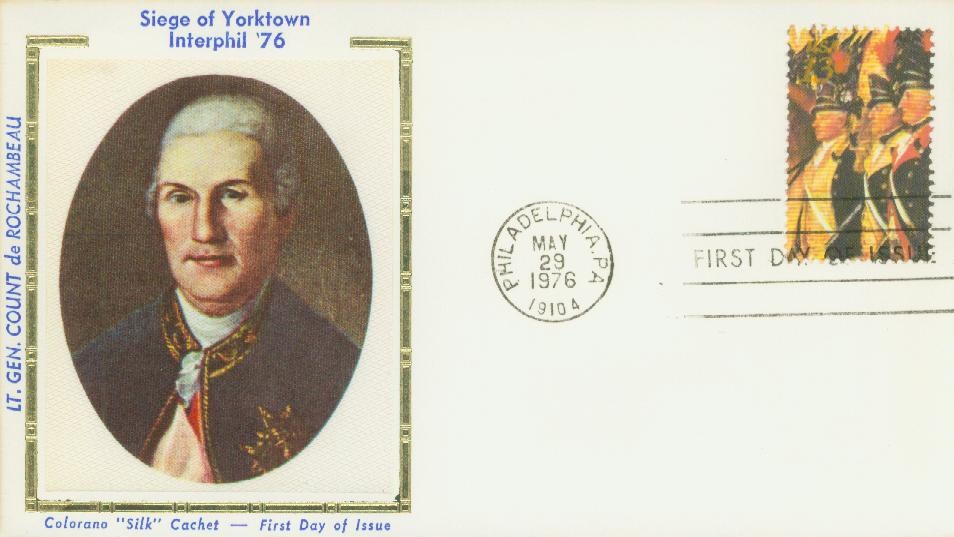
Even before the war had ended, Hamilton realized the Articles of Confederation – the first U.S. Constitution – were too weak to hold the colonies together. He was a delegate for New York to the 1787 convention, which eventually rejected the Articles in favor of a new Constitution. When the Constitution was completed, Hamilton, along with John Jay and James Madison, wrote a series of essays to encourage the ratification. The Federalist Papers explained the document, outlining the new government and answering arguments by those who opposed it. New York ratified the Constitution in 1788.
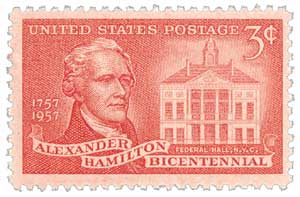
Shortly after Washington was elected the first President of the U.S., he appointed Hamilton as his secretary of the treasury. The nation was deeply indebted to other countries and to the Americans who had supported the war. In 1791, Hamilton presented a bill calling for the formation of the First Bank of the United States. He proposed a system to collect federal taxes, began repayment of war bonds, and had the Federal Government assume the states’ debts. His policies helped establish credit with foreign nations.
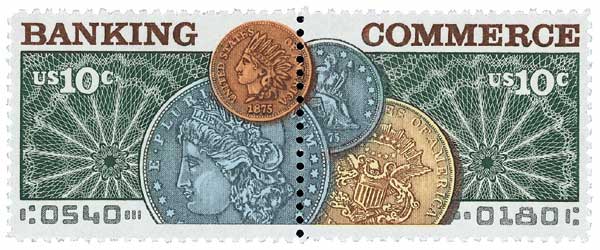
However, Secretary of State Thomas Jefferson disagreed with the bill. He felt that creating such an institution was not within the power of the Federal Government. Hamilton argued that because the power was not forbidden by the Constitution, it was within the right of the government. Political parties formed around these men. Hamilton’s supporters became known as Federalists, while Jefferson’s supporters became the Anti-Federalists, or Democratic-Republicans.
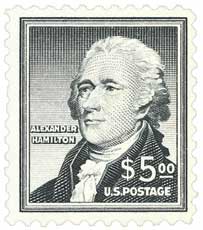
Hamilton also proposed an excise tax on distilled spirits to raise revenue to pay Revolutionary War debts. After it was passed, whiskey producers began a campaign of harassment against federal tax collectors. This civil disobedience turned to armed rebellion in a series of loosely organized uprisings. Hamilton joined President Washington in leading a militia to end the violence. During his term as treasury secretary, Hamilton also composed the Jay Treaty (settling tensions from the Revolution), established public credit and circulating currency, and created a military branch to protect against contraband, which became the U.S. Coast Guard.
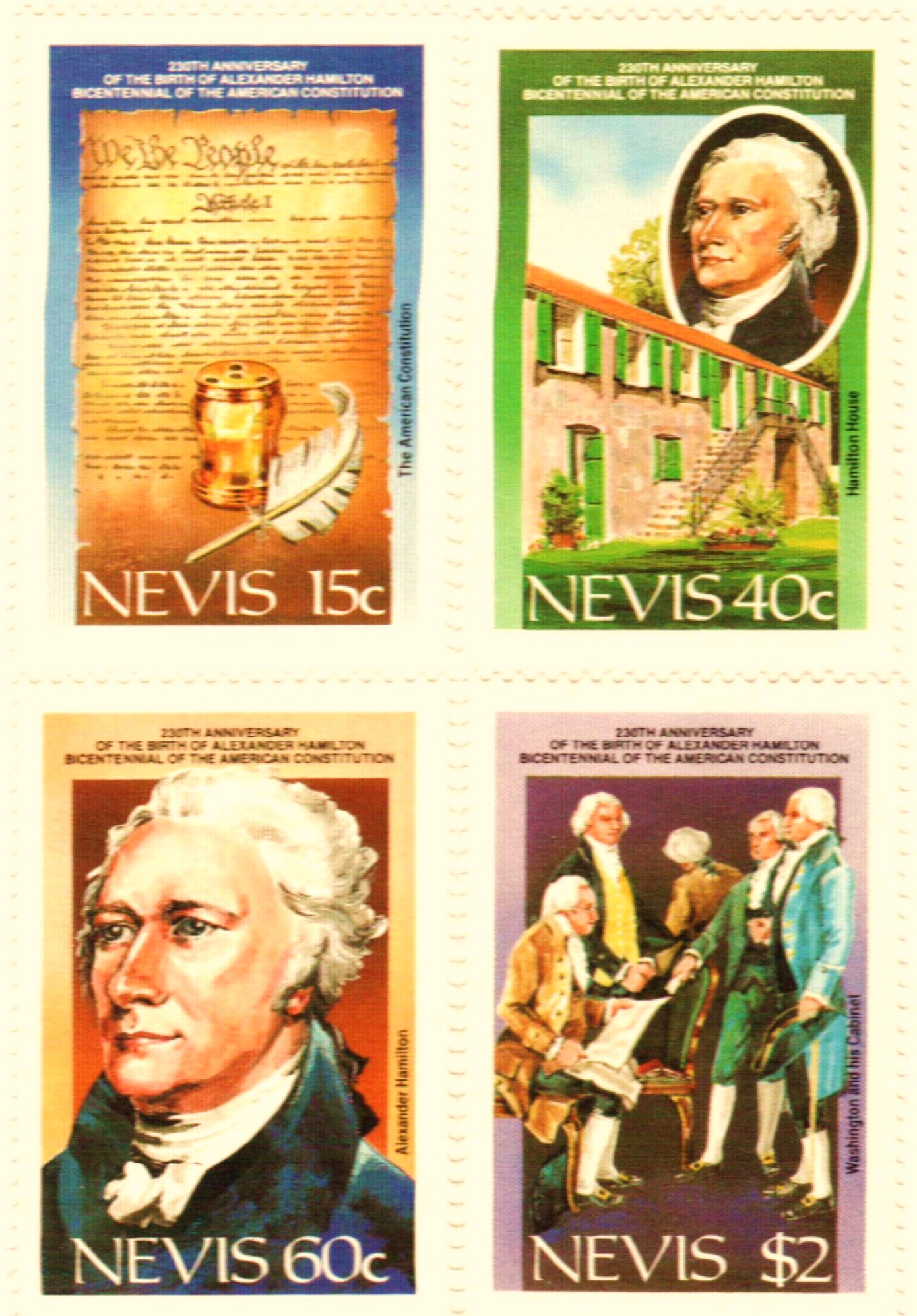
In 1804, after Aaron Burr announced his candidacy for the governorship of New York State, Hamilton joined the race and campaigned vigorously against him. Years of animosity culminated in a duel on July 11, 1804. It’s unsure who fired first. Hamilton’s shot hit a branch above Burr’s head, while Burr hit him in the lower abdomen, causing extensive internal injuries. Hamilton died of his injuries the following day, and Burr was charged with murder.
Birth Of Alexander Hamilton

Alexander Hamilton was born on January 11, 1755 (or 57 – the year is unknown), in Nevis in the British West Indies.
Hamilton began working as a clerk in an accounting office when he was about 11 years old. When his employer realized how bright Hamilton was, he sent him to America for an education. In 1773, Hamilton arrived in New York and attended King’s College. His focus soon turned from education to politics. The following year, he wrote his first article in defense of the patriots’ protests of British taxes.
As the Revolutionary War began, Hamilton commanded the New York Provincial Company of Artillery. He became an assistant to General George Washington, writing many of his letters and reports. In 1781, Hamilton led a charge at the Battle of Yorktown that helped end the war. After the war, Hamilton studied law, then opened a practice in New York City. He represented many Loyalists who had supported England during the Revolution. Hamilton’s cases helped establish the principle of due process in America.

Even before the war had ended, Hamilton realized the Articles of Confederation – the first U.S. Constitution – were too weak to hold the colonies together. He was a delegate for New York to the 1787 convention, which eventually rejected the Articles in favor of a new Constitution. When the Constitution was completed, Hamilton, along with John Jay and James Madison, wrote a series of essays to encourage the ratification. The Federalist Papers explained the document, outlining the new government and answering arguments by those who opposed it. New York ratified the Constitution in 1788.

Shortly after Washington was elected the first President of the U.S., he appointed Hamilton as his secretary of the treasury. The nation was deeply indebted to other countries and to the Americans who had supported the war. In 1791, Hamilton presented a bill calling for the formation of the First Bank of the United States. He proposed a system to collect federal taxes, began repayment of war bonds, and had the Federal Government assume the states’ debts. His policies helped establish credit with foreign nations.

However, Secretary of State Thomas Jefferson disagreed with the bill. He felt that creating such an institution was not within the power of the Federal Government. Hamilton argued that because the power was not forbidden by the Constitution, it was within the right of the government. Political parties formed around these men. Hamilton’s supporters became known as Federalists, while Jefferson’s supporters became the Anti-Federalists, or Democratic-Republicans.

Hamilton also proposed an excise tax on distilled spirits to raise revenue to pay Revolutionary War debts. After it was passed, whiskey producers began a campaign of harassment against federal tax collectors. This civil disobedience turned to armed rebellion in a series of loosely organized uprisings. Hamilton joined President Washington in leading a militia to end the violence. During his term as treasury secretary, Hamilton also composed the Jay Treaty (settling tensions from the Revolution), established public credit and circulating currency, and created a military branch to protect against contraband, which became the U.S. Coast Guard.

In 1804, after Aaron Burr announced his candidacy for the governorship of New York State, Hamilton joined the race and campaigned vigorously against him. Years of animosity culminated in a duel on July 11, 1804. It’s unsure who fired first. Hamilton’s shot hit a branch above Burr’s head, while Burr hit him in the lower abdomen, causing extensive internal injuries. Hamilton died of his injuries the following day, and Burr was charged with murder.








